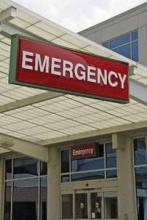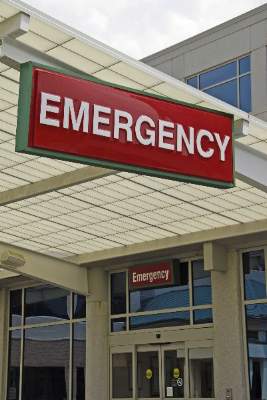User login
An evidence-based care bundle implemented in four U.K. hospitals almost doubled the proportion of lives saved with emergency laparotomy, researchers reported in the British Journal of Surgery.
In addition, 30-day mortality dropped 39%, from 15.6% to 9.6% (risk ratio, 0.61; 95% confidence interval, 0.45 to 0.83; P = .002) at the four hospitals that undertook the quality improvement measures, said Dr. Sam Huddart of Royal Surrey County Hospital NHS Foundation Trust in Guildford, England.
Although a common procedure, emergency laparotomy recently has been linked to death rates of 14% to 19.5% in the United Kingdom, the United States, and Denmark, the researchers said. In the United Kingdom, contributing factors include lack of consultation with surgical and anesthesia specialists, underuse of fluid therapy during surgery, and insufficient use of postoperative ICUs, they added (Br. J. Surg. 2014 Nov. 10 [doi:10.1002/bjs.9658]).
To address these problems, the researchers bundled key recommendations from the Royal College of Surgeons of England and the Department of Health.
The emergency laparotomy pathway quality improvement care (ELPQuiC) bundle included only implemented practices with a strong evidence base, including using an early warning score for all emergency admissions, with graded escalation policies for referring patients to senior clinicians or to the ICU; giving broad-spectrum antibiotics to all patients with sepsis or suspected peritoneal contamination; performing laparotomies within 6 hours of deciding to do so, or as soon as the next available space opened in the emergency operating suite; using goal-directed resuscitation techniques as soon as possible or within 6 hours of admission; and admitting all patients to the ICU after emergency laparotomy, they said.
Eight months later, the number of lives saved per 100 patients treated had risen from 6.47 (or 299 patients) to 12.44 (P < .001), Dr. Huddart and associates reported. “These results were achieved within existing resources, without adversely affecting the length of hospital stay, while the case-mix profile remained relatively stable,” they wrote.
In the regression analysis, only one hospital significantly cut its risk of 30-day mortality, possibly because the study was underpowered. They did not look at emergency laparotomy mortality rates at other hospitals during the study period, they noted.
The research was supported by the Health Foundation, the South West Strategic Health Authority, and LiDCO Group. One coauthor reported receiving lecture fees from LiDCO. The other investigators declared no financial conflicts.
An evidence-based care bundle implemented in four U.K. hospitals almost doubled the proportion of lives saved with emergency laparotomy, researchers reported in the British Journal of Surgery.
In addition, 30-day mortality dropped 39%, from 15.6% to 9.6% (risk ratio, 0.61; 95% confidence interval, 0.45 to 0.83; P = .002) at the four hospitals that undertook the quality improvement measures, said Dr. Sam Huddart of Royal Surrey County Hospital NHS Foundation Trust in Guildford, England.
Although a common procedure, emergency laparotomy recently has been linked to death rates of 14% to 19.5% in the United Kingdom, the United States, and Denmark, the researchers said. In the United Kingdom, contributing factors include lack of consultation with surgical and anesthesia specialists, underuse of fluid therapy during surgery, and insufficient use of postoperative ICUs, they added (Br. J. Surg. 2014 Nov. 10 [doi:10.1002/bjs.9658]).
To address these problems, the researchers bundled key recommendations from the Royal College of Surgeons of England and the Department of Health.
The emergency laparotomy pathway quality improvement care (ELPQuiC) bundle included only implemented practices with a strong evidence base, including using an early warning score for all emergency admissions, with graded escalation policies for referring patients to senior clinicians or to the ICU; giving broad-spectrum antibiotics to all patients with sepsis or suspected peritoneal contamination; performing laparotomies within 6 hours of deciding to do so, or as soon as the next available space opened in the emergency operating suite; using goal-directed resuscitation techniques as soon as possible or within 6 hours of admission; and admitting all patients to the ICU after emergency laparotomy, they said.
Eight months later, the number of lives saved per 100 patients treated had risen from 6.47 (or 299 patients) to 12.44 (P < .001), Dr. Huddart and associates reported. “These results were achieved within existing resources, without adversely affecting the length of hospital stay, while the case-mix profile remained relatively stable,” they wrote.
In the regression analysis, only one hospital significantly cut its risk of 30-day mortality, possibly because the study was underpowered. They did not look at emergency laparotomy mortality rates at other hospitals during the study period, they noted.
The research was supported by the Health Foundation, the South West Strategic Health Authority, and LiDCO Group. One coauthor reported receiving lecture fees from LiDCO. The other investigators declared no financial conflicts.
An evidence-based care bundle implemented in four U.K. hospitals almost doubled the proportion of lives saved with emergency laparotomy, researchers reported in the British Journal of Surgery.
In addition, 30-day mortality dropped 39%, from 15.6% to 9.6% (risk ratio, 0.61; 95% confidence interval, 0.45 to 0.83; P = .002) at the four hospitals that undertook the quality improvement measures, said Dr. Sam Huddart of Royal Surrey County Hospital NHS Foundation Trust in Guildford, England.
Although a common procedure, emergency laparotomy recently has been linked to death rates of 14% to 19.5% in the United Kingdom, the United States, and Denmark, the researchers said. In the United Kingdom, contributing factors include lack of consultation with surgical and anesthesia specialists, underuse of fluid therapy during surgery, and insufficient use of postoperative ICUs, they added (Br. J. Surg. 2014 Nov. 10 [doi:10.1002/bjs.9658]).
To address these problems, the researchers bundled key recommendations from the Royal College of Surgeons of England and the Department of Health.
The emergency laparotomy pathway quality improvement care (ELPQuiC) bundle included only implemented practices with a strong evidence base, including using an early warning score for all emergency admissions, with graded escalation policies for referring patients to senior clinicians or to the ICU; giving broad-spectrum antibiotics to all patients with sepsis or suspected peritoneal contamination; performing laparotomies within 6 hours of deciding to do so, or as soon as the next available space opened in the emergency operating suite; using goal-directed resuscitation techniques as soon as possible or within 6 hours of admission; and admitting all patients to the ICU after emergency laparotomy, they said.
Eight months later, the number of lives saved per 100 patients treated had risen from 6.47 (or 299 patients) to 12.44 (P < .001), Dr. Huddart and associates reported. “These results were achieved within existing resources, without adversely affecting the length of hospital stay, while the case-mix profile remained relatively stable,” they wrote.
In the regression analysis, only one hospital significantly cut its risk of 30-day mortality, possibly because the study was underpowered. They did not look at emergency laparotomy mortality rates at other hospitals during the study period, they noted.
The research was supported by the Health Foundation, the South West Strategic Health Authority, and LiDCO Group. One coauthor reported receiving lecture fees from LiDCO. The other investigators declared no financial conflicts.
Key clinical point: A set of quality improvement measures cut 30-day emergency laparotomy mortality by about 39%.
Major finding: Thirty-day mortality dropped from 15.6% to 9.6% (risk ratio, 0.61; 95% confidence interval, 0.45 to 0.83; P = .002).
Data source: Prospective, 8-month study of emergency laparotomy outcomes at four hospitals in England.
Disclosures: The research was supported by the Health Foundation, the South West Strategic Health Authority, and LiDCO Group. One coauthor reported receiving lecture fees from LiDCO. The other investigators declared no financial conflicts.

